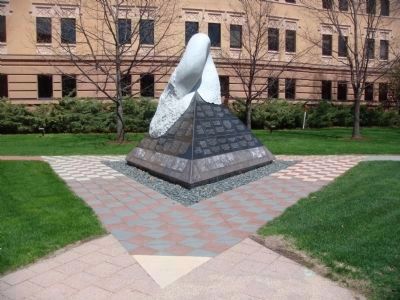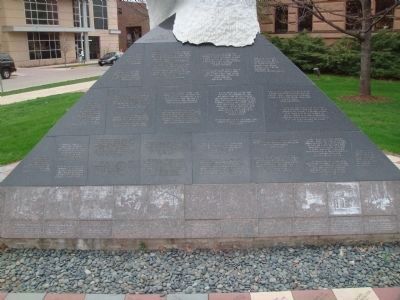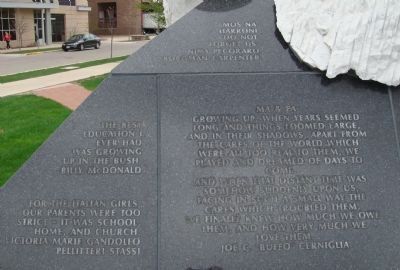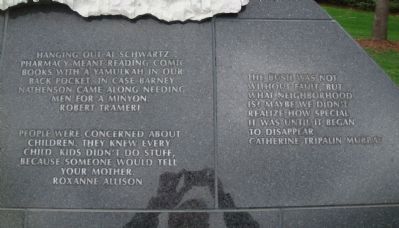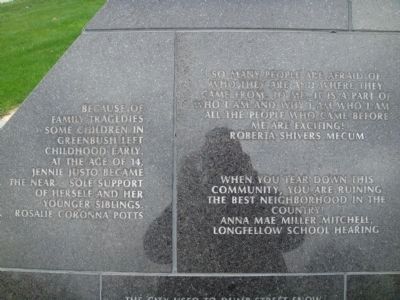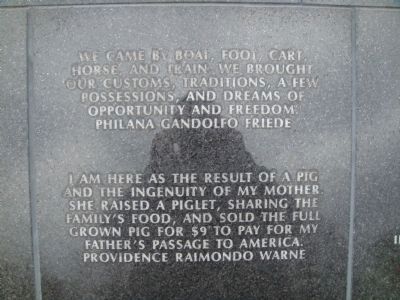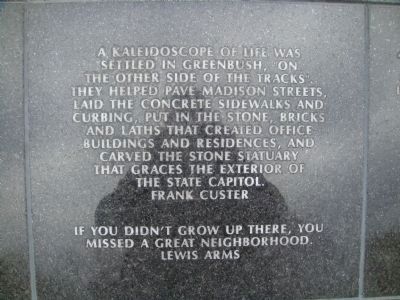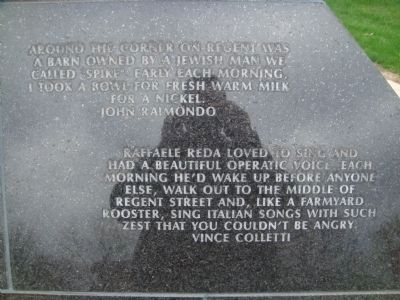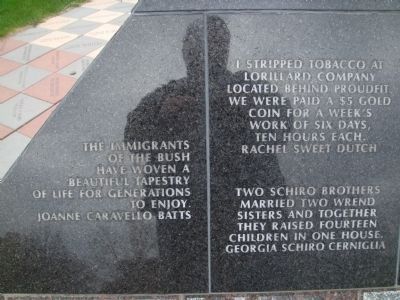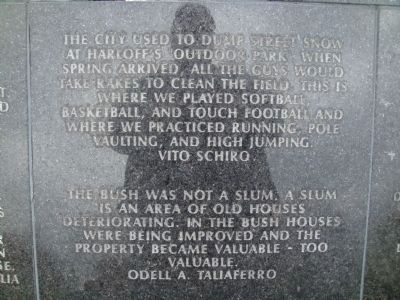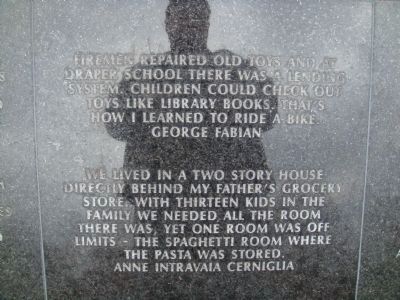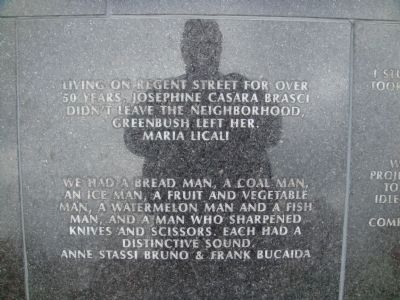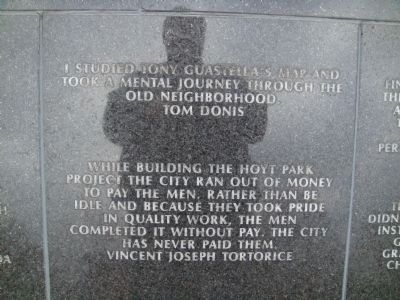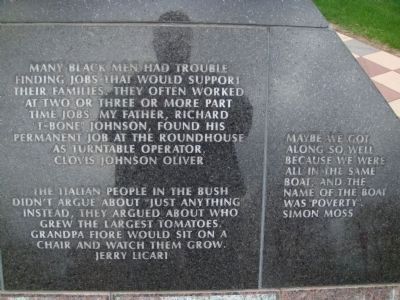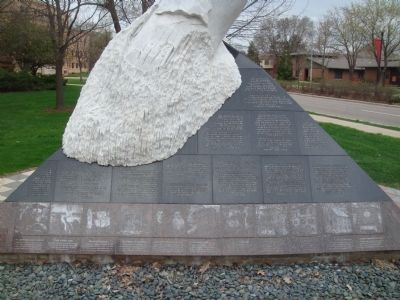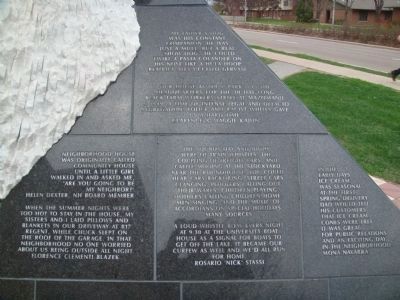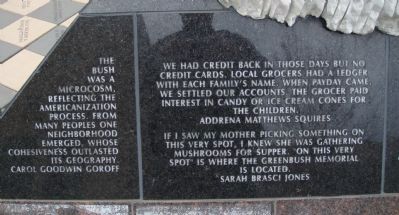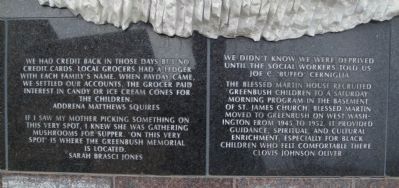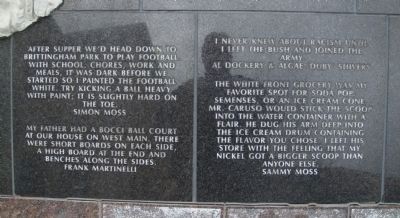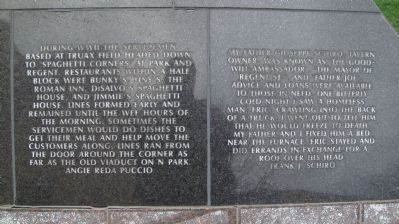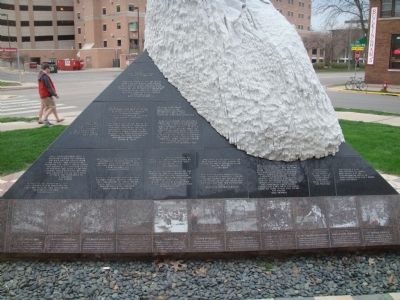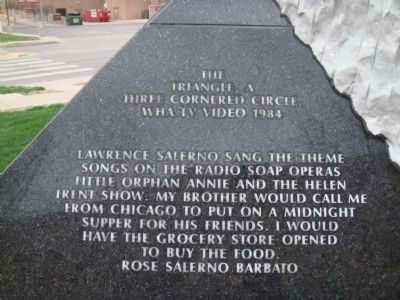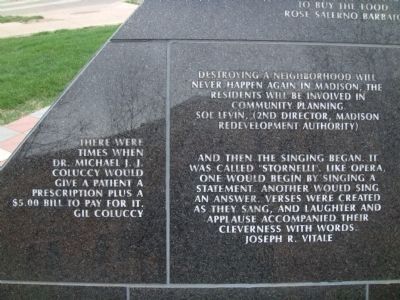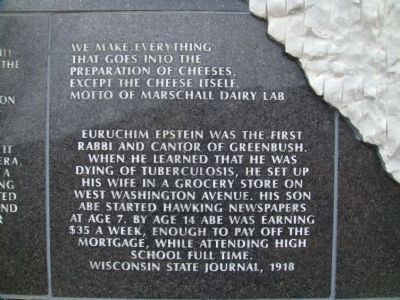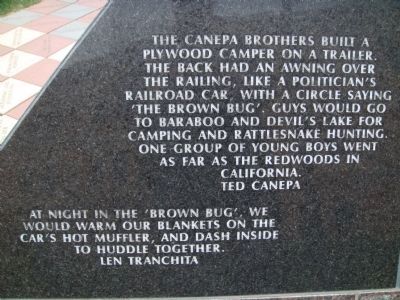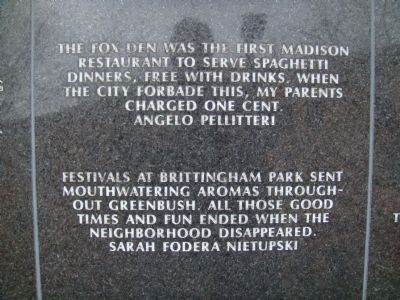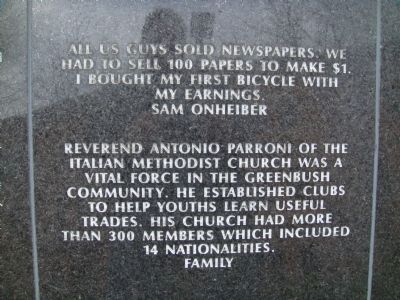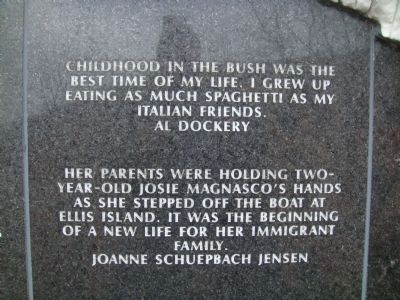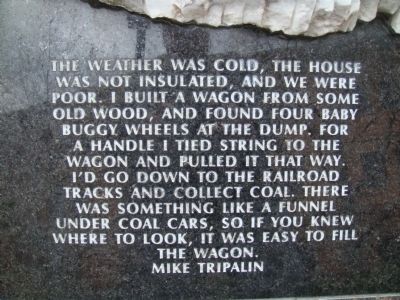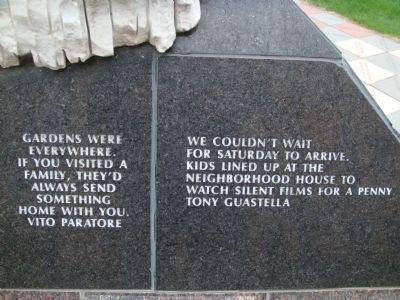Madison in Dane County, Wisconsin — The American Midwest (Great Lakes)
Spirit of Greenbush
Inscription.
[South Side:]
Mos na harroni. Do not forget us.
Nina Pecoraro Borgman Carpenter
The best education I ever had was growing up in the Bush.
Billy McDonald
For the Italian girls our parents were too strict. It was school, home, and church.
Victoria Marie Gandolfo Pelliteri Stassi
Ma & Pa
Growing up, when years seemed long and things loomed large, and in their shadows, apart from the cares of the world which were all too real to them, we played and dreamed of days to come.
And when that distant time was somehow suddenly upon us, facing in such a small way the cares which troubled them, we finally knew how much we owe them, and how very much we love them.
Joe C. "Buffo" Cerniglia
Hanging out at Schwartz Pharmacy meant reading comic books with a yamulkah in our back pocket, in case Barney Nathenson came along needing men for a minyon.
Robert Trameri
People were concerned about children. They knew every child. Kids didn't do stuff, because someone would tell your mother.
Roxanne Allison
The Bush was not without fault, but what neighborhood is? Maybe we didn't realize how special it was until it began to disappear.
Catherine Tripalin Murray
Because of family tragedies some children in Greenbush left childhood early. At the age of 14, Jennie Justo became the near-sole support of herself and her younger siblings.
- Rosalie Coronna Potts
So many people are afraid of who they are and where they came from. To me, it is a part of who I am and why I am who I am[.] All the people who came before me are exciting!
- Roberta Shivers Mecum
When you tear down this community, you are ruining the best neighborhood in the country!
Anna Mae Miller Mitchell, Longfellow School Hearing
We came by boat, foot, cart, horse, and train. We brought our customs, traditions, a few possessions, and dreams of opportunity and freedom.
Philana Gandolfo Friede
I am here as the result of a pig and the ingenuity of my mother. She raised a piglet, sharing the family's food, and sold the full grown pig for $9 to pay for my father's passage to America.
Providence Raimondo Warne
A kaleidoscope of life was settled in Greenbush, "on the other side of the tracks". They helped pave Madison streets, laid the concrete sidewalks and curbing, put in the stone, bricks and laths that created office buildings and residences, and carved the stone statuary that graces the exterior of the State Capitol.
Frank Custer
If you didn't grow up there, you missed a great neighborhood.
Lewis Arms
Around the corner on Regent was
a barn owned by a Jewish man we called "Spike". Early each morning I took a bowl for fresh warm milk for a nickel.
John Raimondo
Raffaele Reda loved to sing and had a beautiful operatic voice. Each morning he'd wake up before anyone else, walk out to the middle of Regent Street and, like a farmyard rooster, sing Italian songs with such zest that you couldn't be angry.
Vince Colletti
The immigrants of the Bush have woven a beautiful tapestry of life for generations to enjoy.
Joanne Caravello Batts
I stripped tobacco at Lorillard Company located behind Proudfit. We were paid a $5 gold coin for week's work of six days, ten hours each.
Rachel Sweet Dutch
Two Schiro brothers married two Wrend sisters and together they raised fourteen children in one house.
Georgia Schiro Cerniglia
The city used to dump street snow at Harloff's outdoor park. When spring arrived, all the guys would take rakes to clean the field. This is where we played softball, basketball, and touch football and where we practiced running, pole vaulting, and high jumping.
Vito Schiro
The Bush was not a slum. A slum is an area of old houses deteriorating. In the Bush houses were being improved and the property became valuable - too valuable.
Odell A. Taliaferro
Firemen repaired old toys and at Draper
School there was a lending system. Children could check out toys like library books. That's how I learned to ride a bike.
George Fabian
We lived in a two story house directly behind my father's grocery store. With thirteen kids in the family we needed all the room there was, yet one room was off limits - the spaghetti room where the pasta was stored.
Anne Intravaia Cerniglia
Living on Regent Street for over 50 years, Josephine Casara Brasci didn't leave the neighborhood, Greenbush left her.
Maria Licali
We had a bread man, a coal man, an ice man, a fruit and vegetable man, a watermelon man and a fish man, and a man who sharpened knives and scissors. Each had a distinctive sound.
Anne Stassi Bruno & Frank Bucaida
Many black men had trouble finding jobs that would support their families. They often worked at two or three or more part time jobs. My father, Richard "T-Bone" Johnson, found his permanent job at the Roundhouse as a turntable operator.
Clovis Johnson Oliver
The Italian people in the Bush didn't argue about "just anything." Instead, they argued about who grew the largest tomatoes. Grandpa Fiore would sit on a chair and watch them grow.
Jerry Licari
Maybe we got along so well because we were all in the same boat, and the name of the boat was "Poverty."
Simon Moss
[West
Side:]
My father's dog was his constant companion. He was just a mutt, but a real "show dog." He could twirl a pasta colander on his nose like a hula hoop.
Beatrice Ales Uccello Gervasi
Our house at 109 S. Park was the headquarters for the 30-day-long Black farm workers strike at Mazomanie in 1949, a time of intense legal and de facto segregation. Police and racist whites gave us a hard time.
Clarence & Maggie Kailin
Neighborhood House was originally called Community House until a little girl walked in and asked me, "Are you going to be my neighbor?"
Helen Dexter, NH Board Member
When the summer nights were too hot to stay in the house, my sisters and I laid pillows and blankets in our driveway at 817 Regent, while Chuck slept on the roof of the garage. In that neighborhood no one worried about us being outside all night.
Florence Clementi Blazek
The sounds of day and night were of train whistles, the coupling of freight cars, and cattle mooing at the stockyard near the Roundhouse. You could hear cars backfiring, street cars clanging, peddlers calling out their wares, children playing, mothers calling children home, men singing, and the music of accordians on special holidays.
Many sources
A loud whistle blew every night at 9:30 at the University Boat
House as a signal for boats to get off the lake. It became our curfew as well and we'd all run for home.
Rosario "Nick" Stassi
In the early days ice cream was seasonal. At the first spring delivery Dad would tell his customers that ice cream cones were free. It was great for public relations and an exciting day in the neighborhood.
Mona Navarra
The Bush was a microcosm, reflecting the Americanization process. From many peoples one neighborhood emerged, whose cohesiveness outlasted its geography.
Carol Goodwin Goroff
We had credit back in those days but no credit cards. Local grocers had a ledger with each family's name. When payday came, we settled our accounts. The grocer paid interest in candy or ice cream cones for children.
Addrena Matthews Squires
If I saw my mother picking something on this very spot, I knew she was gathering mushrooms for supper. "On this very spot" is now where the Greenbush Memorial is located.
Sarah Brasci Jones
We didn't know we were deprived until the social workers told us.
Joe C. "Buffo" Cerniglia
The Blessed Martin House recruited Greenbush children to a Saturday morning program in the basement of St. James Church. Blessed Martin moved to Greenbush on West Washington from 1945 to 1952. It provided guidance, spiritual,
and cultural enrichment, especially for Black children, who felt comfortable there.
Clovis Johnson Oliver
After supper we'd head down to Brittingham Park to play football. With school, chores, work, and meals, it was dark before we started so I painted the football white. Try kicking a ball heavy with paint; it's slightly hard on the toe.
Simon Moss
My father had a bocci ball court at our house on West Main. There were short boards on each side, a high board at the end and benches along the sides.
Frank Martinelli
I never knew about racism until I left the Bush and joined the Army.
Al Dockery & Algae "Duby" Shivers
The White Front Grocery was my favorite spot for soda pop, semenses or an ice cream cone. Mr. Caruso would stick the scoop into the water container with a flair. He dug his arm deep into the ice cream drum containing the flavor you chose. I left his store with the feeling that my nickel got a bigger scoop than anyone else.
Sammy Moss
During WWII the servicemen based at Truax Field headed down to "Spaghetti Corners" at Park and Regent. Restaurants within a half block were Bunky's, Tiny's, the Roman Inn, DiSalvo's Spaghetti House, and Jimmie's Spaghetti House. Lines formed early and remained until the wee hours of the morning. Sometimes the servicemen would
do dishes to get their meal and help move the customers along. Lines ran from the door around the corner as far as the old viaduct on N. Park.
Angie Reda Puccio
My father Guiseppe Schiro, tavern owner, was known as "The Goodwill Ambassador," "The Mayor of Regent St.," and "Father Joe." Advice and loans were available to those in need. One bitterly cold night I saw a homeless man, Eric, crawling into the back of a truck. I went out to tell him he would freeze to death. My father and I fixed him a bed near the furnace. Eric stayed and did errands in exchange for a roof over his head.
Frank J. Schiro
[Northeast Side:]
The Triangle, a three cornered circle.
WHA TV Video 1984
Lawrence Salerno sang the theme songs on the radio soap operas Little Orphan Annie and The Helen Trent Show. My brother would call me from Chicago to put on a midnight supper for his friends. I would have the grocery store opened to buy the food.
Rose Salerno Barbato
There were times when Dr. Michael J.J. Coluccy would give a patient a prescription plus a $5.00 bill to pay for it.
Gil Coluccy
Destroying a neighborhood will never happen again in Madison. The residents will be involved in community planning.
Sol Levin, (2nd Director, Madison Redevelopment Authority)
And then the singing began.
It was called "Stornelli". Like opera, one would begin by singing a statement. Another would sing an answer. Verses were created as they sang, and laughter and applause accompanied their cleverness with words.
Joseph R. Vitale
We make everything that goes into the preparation of cheeses, except the cheese itself.
Motto of Marschall Dairly Lab
Euruchim Epstein was the first rabbi and cantor of Greenbush. When he learned that he was dying of tuberculosis, he set up his wife in a grocery store on West Washington Avenue. His son Abe started hawking newspapers at age 7. By age 14 Abe was earning $35 a week, enough to pay off the mortgage, while attending high school full time.
Wisconsin State Journal, 1918
The Canepa Brothers built a plywood camper on a trailer. The back had an awning over the railing, like a politician's railroad car, with a circle saying 'The Brown Bug'. Guys would go to Baraboo and Devil's Lake for camping and rattlesnake hunting. One group of young boys went as far as the redwoods in California.
Ted Canepa
At night in the 'Brown Bug', we would warm our blankets on the car's hot muffler, and dash inside to huddle together.
Len Tranchita
The Fox Den was the first Madison restaurant to serve spaghetti dinners, free with drinks. When the city forbade this, my parents charged one cent.
Angelo
Pellitteri
Festivals at Brittingham Park sent mouthwatering aromas throughout Greenbush. All those good times and fund ended when the neighborhood disappeared.
Sarah Fodera Nietupski
All us guys sold newspapers. We had to sell 100 papers to make $1. I bought my first bicycle with my earnings.
Sam Onheiber
Reverend Antonio Parroni of the Italian Methodist Church was a vital force in the Greenbush community. He established clubs to help youths learn useful trades. His church had more than 300 members which included 14 nationalities.
Family
Childhood in the Bush was the best time of my life. I grew up eating as much spaghetti as my Italian friends.
Al Dockery
Her parents were holding two-year-old Josie Macnasco's hands as she stepped off the boat at Ellis Island. It was the beginning of a new life for her immigrant family.
Joanne Schuepbach Jensen
The weather was cold, the house was not insulated, and we were poor. I built a wagon from some old wood, and found four baby buggy wheels at the dump. For a handle, I tied string to the wagon and pulled it that way. I'd go down to the railroad tracks and collect coal. There was something like a funnel under coal cars, so if you knew where to look, it was easy to fill the wagon.
Mike Tripalin
Gardens were everywhere. If you visited
a family, they'd always send something home with you.
Vito Paratore
We couldn't wait for Saturday to arrive. Kids lined up at the Neighborhood House to watch silent films for a penny.
Tony Guastella
Erected 2000.
Topics. This historical marker is listed in these topic lists: African Americans • Notable Places • Settlements & Settlers. A significant historical year for this entry is 1949.
Location. 43° 4.073′ N, 89° 23.944′ W. Marker is in Madison, Wisconsin, in Dane County. Marker is at the intersection of Regent Street and North Murray Street, on the right when traveling west on Regent Street. Touch for map. Marker is in this post office area: Madison WI 53703, United States of America. Touch for directions.
Other nearby markers. At least 8 other markers are within walking distance of this marker. The Greenbush (about 500 feet away, measured in a direct line); Schmidt's Auto, Inc. (about 600 feet away); Italian Workmen's Club (about 800 feet away); Milwaukee Road Depot (approx. ¼ mile away); Longfellow School (approx. ¼ mile away); Wiedenbeck-Dobelin Warehouse (approx. ¼ mile away); a different marker also named Greenbush (approx. 0.3 miles away); Washington Grade and Orthopedic School (approx. 0.3 miles away). Touch for a list and map of all markers in Madison.
More about this marker. The marker was created by
sculptor Antonio Testolin. In the pamphlet distributed at the dedication ceremony, he said "Within the sculpture, I chose to express this theme [of true community] with two figures carved in marble reaching out for each other. They are stylized to represent any ethnic background or gender. Their heads are turned away so as to be unaware or indifferent to what race or ethnic background they are helping. A drapery shrouds them -- symbolic of the community that surrounds and protects its residents. The image is intentionally subtle; I hope to draw a viewer more closely to the piece and create a sense of discovery, as the shapes within the sculpture and their meanings become more apparent. ...
"This section was carved from a 20-ton Carrara marble block quarried in Italy. I selected this material for the high quality stone and the symbolic importance of its Italian origin. I left the stone rough and jagged at the bottom. This somewhat unpleasant, deteriorating look communicates a distress. I wanted this portion to reflect that the neighborhood was destroyed as part of an urban renewal project in the 1960s. From the rough and jagged stone, the sculpture then rises into smooth and polished shapes and images, signifying that even after the destruction of the neighborhood, the wonderful relationships and spirit that were developed continue to flourish and rise above it all.
"Because
of the sculpture's public venue -- where we all communicate and express ourselves in different ways -- I felt that it was necessary to incorporate several media. I purposely incorporated written, visual, as well as abstract images in order to make connections with a wide range of viewers."
Related markers. Click here for a list of markers that are related to this marker. This is a list of markers regarding the Greenbush neighborhood.
Also see . . . Saving the "Spirit of Greenbush" statue. An article on efforts to restore the faded marker. (Submitted on August 14, 2014, by William J. Toman of Green Lake, Wisconsin.)
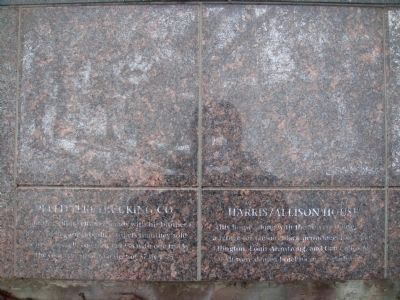
Photographed By William J. Toman, April 30, 2011
31. Closeup of South Side of Spirit of Greenbush Marker
These are the first and second panels of "The Images of Greenbush" on this side of the sculpture.
Pellitteri Trucking Co.
Founder Phillip Pellitteri stands with his brother Ben beside discarded bushel baskets that they sold for 10 cents each. Starting in 1938 with one truck, the company boasted a fleet of 57 by 1975.
Harris/Allison House
This house, along with the Shivers House, was a refuge for famous black performers like Duke Ellington, Louis Armstrong, and Cab Calloway. All were denied hotel rooms in Madison.
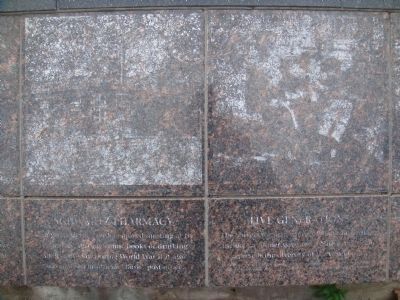
Photographed By William J. Toman, April 30, 2011
32. Closeup of South Side of Spirit of Greenbush
These are the third and fourth panels of "The Images of Greenbush" on this side of the sculpture.
Schwartz Pharmacy
Youngsters of the Bush enjoyed meeting at the Pharmacy, reading comic books or drinking milks or sodas. During World War II it also became an unofficial "Bush" post office.
Five Generations
The Shivers women, whose ancestors were Italian, Irish, German, a former slave, and a Native American, represent the diversity of the Greenbush.
(L to R: Hazel Shivers Taliaferro, her mother, Else Neumann Shivers, Hazel's grandmother, Rebecca Peters Shivers, holding Hazel's baby, Joan Taliaferro, and Hazel's great grandmother, Eliza Murphy Peters.)
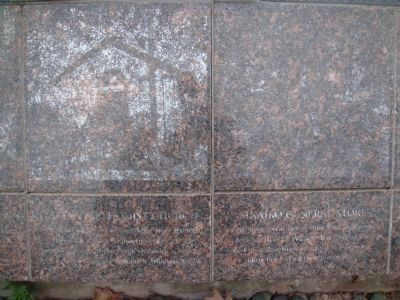
Photographed By William J. Toman, April 30, 2011
33. Closeup of South Side of Spirit of Greenbush
These are the fifth and sixth panels of "The Images of Greenbush" on this side of the sculpture.
Italian Methodist Church
Sicilian-Albanians of the "Bush" were attracted to this church since its practices most closely resembled those of the Greek Orthodox Church they followed in Piana dei Greci Albanesi, Sicily.
Sinaiko General Store
Shown here a year before their Park St. store was lost to a fire in 1922 are William and Pauline Sinaiko, and their daughters, who escaped from the blaze but lost all their possessions.
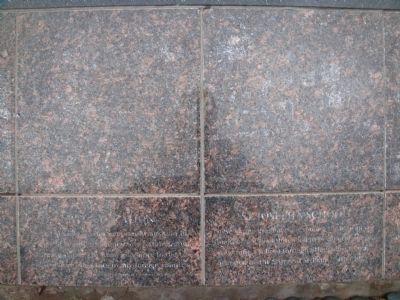
Photographed By William J. Toman, April 30, 2011
34. Closeup of South Side of Spirit of Greenbush
These are the seventh and eighth panels of "The Images of Greenbush" on this side of the sculpture.
Naturalization
U.S citizenship was an important transition in the lives of Greenbush immigrants. Naturalization required that applicants swear allegiance to the United States and renounce allegiance to any foreign country.
Pictured are the naturalization papers of Pietro and Antonina Capacio.
St. Joseph's School
These happy graduates were among the final class of 1963. Intended to be an orphanage, it became a school through 8th grade that was operated by the Sisters of St. Francis after 1925.
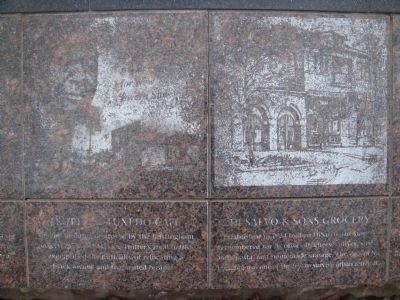
Photographed By William J. Toman, April 30, 2011
35. Closeup of South Side of Spirit of Greenbush
These are the ninth and tenth panels of "The Images of Greenbush" on this side of the sculpture.
Trotter's Tuxedo Cafe
The last building destroyed by the Brittingham project, Zach and Maxine Trotter's legal battles exemplified the difficulty of relocating a black-owned and frequented business.
DiSalvo and Sons Grocery
Established in 1924 by Ben DiSalvo, the store is remembered for its olive oil, cheese, olives, snails, bulk pasta and homemade sausage. The Regent St. building was one of the few to survive urban renewal.
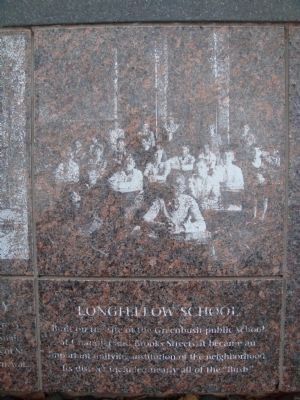
Photographed By William J. Toman, April 30, 2011
36. Closeup of South Side of Spirit of Greenbush
This is the eleventh panel of "The Images of Greenbush" on this side of the sculpture.
Longfellow School
Built on the site of the Greenbush public school at Chandler and Brooks Streets, it became an important unifying institution of the neighborhood. Its district included nearly all of the "Bush."
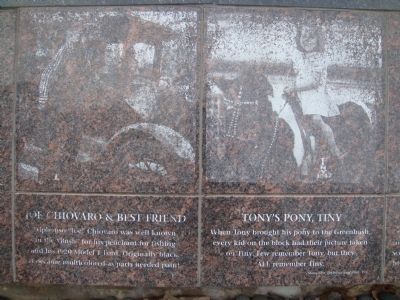
Photographed By William J. Toman, April 30, 2011
37. Closeup of West Side of Spirit of Greenbush
These are the first and second panels of "The Images of Greenbush" on this side of the sculpture.
Joe Chiovaro & Best Friend
Alphonso "Joe" Chiovaro was well-known in the "Bush" for his penchant for fishing and his 1920 Model T Ford. Originally black, it became multicolored as parts needed paint.
Tony's Pony, Tiny
When Tony brought his pony to the Greenbush, every kid on the block had their picture on Tiny. Few remember Tony, but they ALL remember Tiny.
(Maryellen Tortorice and Tiny, 1943)
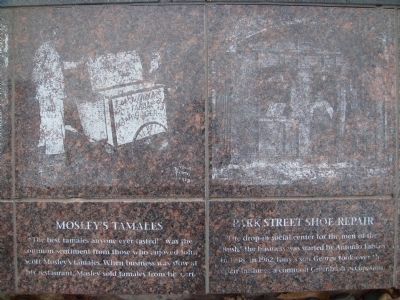
Photographed By William J. Toman, April 30, 2011
38. Closeup of West Side of Spirit of Greenbush
These are the third and fourth panels of "The Images of Greenbush" on this side of the sculpture.
Mosley's Tamales
"The best tamales anyone ever tasted!" was the common sentiment from those who enjoyed John Scott Mosley's tamales. When business was slow at his restaurant, Mosley sold tamales from his cart.
Park Street Shoe Repair
The drop-in social center for the men of the "Bush," the business was started by Antonio Fabian in 1938. In 1962 Tony's son George took over the repair business, a common Greenbush occupation.
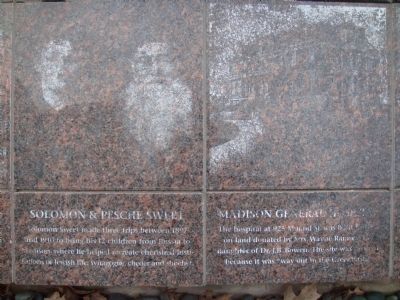
Photographed By William J. Toman, April 30, 2011
39. Closeup of West Side of Spirit of Greenbush
These are the fifth and sixth panels of "The Images of Greenbush" on this side of the sculpture.
Solomon & Pesche Sweet
Solomon Sweet made three trips between 1897 and 1910 to bring his 12 children from Russia to Madison, where he helped recreate cherished institutions of Jewish life: synagogue, cheder and shochet.
Madison General Hospital
The hospital at 925 Mound St. was built in 1903 on land donated by Mrs. Wayne Ramsey, the daughter of Dr. J.B. Bowen. The site was favored because it was "way out in the Greenbush."
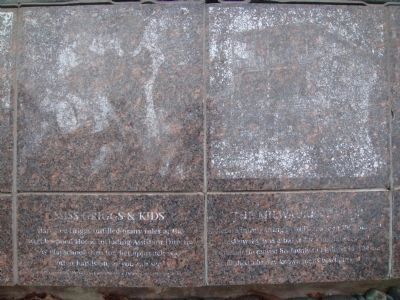
Photographed By William J. Toman, April 30, 2011
40. Closeup of West Side of Spirit of Greenbush
These are the seventh and eighth panels of "The Images of Greenbush" on this side of the sculpture.
Miss Griggs & Kids
Mary Lee Griggs fulfilled many roles at the Neighborhood House including Assistant Director. As Playschool Director, her approach was often hands-on, as you can see.
(Pictured with Miss Griggs: Catherine Oliva, Delores Caire, and Sam Moskowsky)
The Milwaukee Bakery
Before immigrating to Milwaukee in 1911, Samuel Moskowsky was a baker for King Edward VII in England. He moved his family to Madison in 1924 and established a bakery known for its hearth-baked breads.
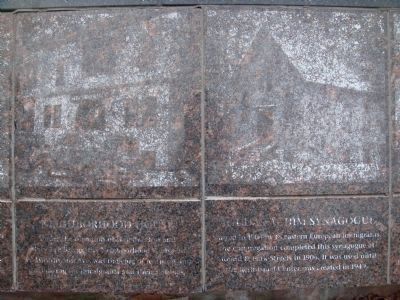
Photographed By William J. Toman, April 30, 2011
41. Closeup of West Side of Spirit of Greenbush
These are the ninth and tenth panels of "The Images of Greenbush" on this side of the sculpture.
Neighborhood House
Under the direction of Gay Braxton and Mary Lee Briggs, the Neighborhood House on W. Washington Ave. was the core of learning and socializing for immigrants and their families.
Agudas Aghim Synagogue
Started in 1904 by 18 eastern European immigrants, the congregation completed this synagogue at Mound & Park Streets in 1906. It was used until the Beth Israel Center was created in 1949.
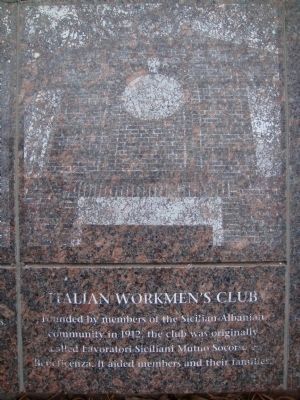
Photographed By William J. Toman, April 30, 2011
42. Closeup of West Side of Spirit of Greenbush
This is the eleventh panel of "The Images of Greenbush" on this side of the sculpture.
Italian Workmen's Club
Founded by members of the Sicilian-Albanian community in 1912, the club was originally called Lavoratori Siciliani Mutuo Soccorso Beneficenza. It aided members and their families.
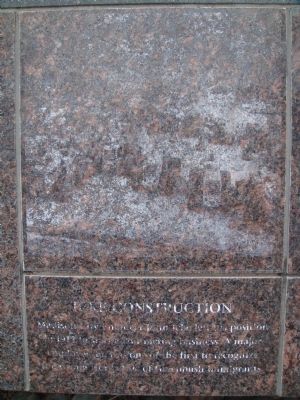
Photographed By William J. Toman, April 30, 2011
43. Closeup of Northeast Side of Spirit of Greenbush
This is the first panel of "The Images of Greenbush" on this side of the sculpture.
Icke Construction
Madison City Engineer John Icke left his position in 1912 to start a contracting business. A major employer, he was one of the first to recognize the strong work ethic of Greenbush immigrants.
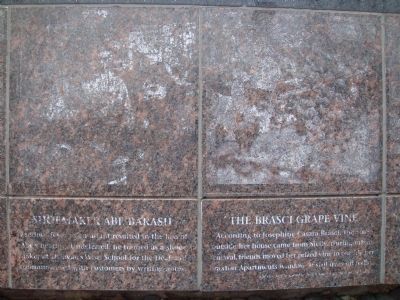
Photographed By William J. Toman, April 30, 2011
44. Closeup of Northeast Side of Spirit of Greenbush
These are the second and third panels of "The Images of Greenbush" on this side of the sculpture.
Shoemaker Abe Barash
A serious fever as an infant resulted in the loss of Abe's hearing. Undeterred, he trained as a shoe maker at Delavan's Wisc. School for the Deaf and communicated with customers by writing notes.
The Brasci Grape Vine
According to Josephine Casara Brasci, the vine outside her house came from Sicily. During urban renewal, friends moved her prized vine to outside her Braxton Apartments window. It still lives on today.
The vine is propagated by Jung's Nursery as "King of the North"
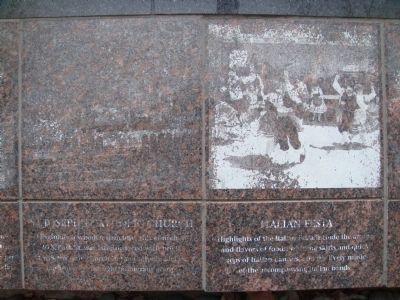
Photographed By William J. Toman, April 30, 2011
45. Closeup of Northeast Side of Spirit of Greenbush
These are the fourth and fifth panels of "The Images of Greenbush" on this side of the sculpture.
St. Joseph's Catholic Church
Originally a wooden structure, this church at 10 S. Park St. was later surfaced with brick. It was the only church in the Catholic diocese built to serve a single immigrant group.
Italian Festa
Highlights of the Italian Festa include the aromas and flavors of foods, whirling skirts and quick steps of Italian dancers, and the lively music of the accompanying Italian bands.
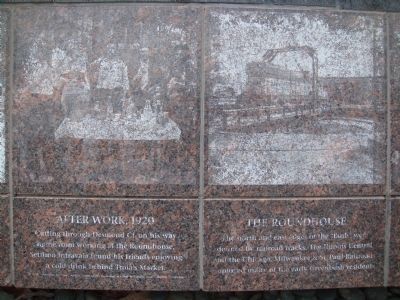
Photographed By William J. Toman, April 30, 2011
46. Closeup of Northeast Side of Spirit of Greenbush
These are the sixth and seventh panels of "The Images of Greenbush" on this side of the sculpture.
After Work, 1920
Cutting through Desmond Ct. on his way home from working at the Roundhouse, Settimo Intravaia found his friends enjoying a cold drink behind Troia's Market.
(L to R: Mariano Sansone, Natale Troia, Carlo Badenna, Settimo Intravaia, and Cologero Intravaia)
The Roundhouse
The north and east edges of the "Bush" were defined by railroad tracks. The Illinois Central and the Chicago, Milwaukee & St. Paul Railroads employed many of the early Greenbush residents.
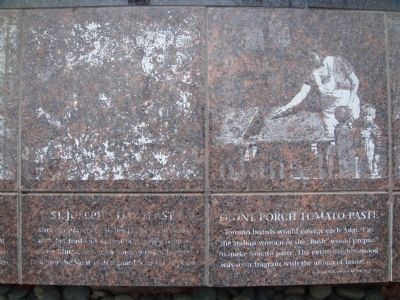
Photographed By William J. Toman, April 30, 2011
47. Closeup of Northeast Side of Spirit of Greenbush
These are the eighth and ninth panels of "The Images of Greenbush" on this side of the sculpture.
St. Joseph's Day Feast
After her prayers to St. Joseph were answered with her husband Antonio's recovery from a serious illness, Antonina Bonanno kept her vow to honor the Saint with grand feast for 37 years.
Front Porch Tomato Paste
Tomato boards would emerge each August as the Italian women of the "Bush" would prepare to make tomato paste. The entire neighbhorhood was soon fragrant with the aroma of tomatoes.
(Loretta Falci on her Milton St. porch)
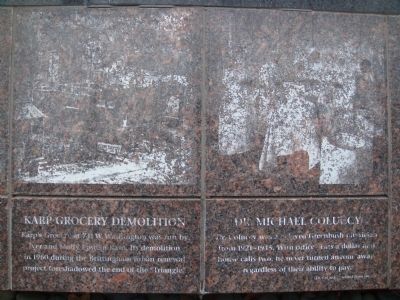
Photographed By William J. Toman, April 30, 2011
48. Closeup of Northeast Side of Spirit of Greenbush
These are the tenth and eleventh panels of "The Images of Greenbush" on this side of the sculpture.
Karp Grocery Demolition
Karp's Grocery at 731 W. Washington was run by Iver and Molly Epstein Karp. Its demolition in 1960 during the Brittingham urban renewal project foreshadowed the end of the "Triangle."
Dr. Michael Coluccy
Dr. Coluccy was a beloved Greenbush physician from 1921-1945. With office visits a dollar and house calls two, he never turned anyone away regardless of their ability to pay.
(Dr. Coluccy is second from the left)
Credits. This page was last revised on June 16, 2016. It was originally submitted on May 2, 2011, by William J. Toman of Green Lake, Wisconsin. This page has been viewed 4,129 times since then and 424 times this year. It was the Marker of the Week June 16, 2013. Photos: 1. submitted on May 2, 2011, by William J. Toman of Green Lake, Wisconsin. 2. submitted on May 3, 2011, by William J. Toman of Green Lake, Wisconsin. 3, 4, 5, 6, 7. submitted on May 5, 2011, by William J. Toman of Green Lake, Wisconsin. 8. submitted on May 6, 2011, by William J. Toman of Green Lake, Wisconsin. 9, 10, 11, 12, 13. submitted on May 8, 2011, by William J. Toman of Green Lake, Wisconsin. 14. submitted on May 6, 2011, by William J. Toman of Green Lake, Wisconsin. 15. submitted on May 2, 2011, by William J. Toman of Green Lake, Wisconsin. 16, 17, 18, 19, 20. submitted on May 3, 2011, by William J. Toman of Green Lake, Wisconsin. 21. submitted on May 8, 2011, by William J. Toman of Green Lake, Wisconsin. 22, 23, 24, 25, 26, 27, 28, 29, 30, 31. submitted on May 19, 2011, by William J. Toman of Green Lake, Wisconsin. 32, 33, 34. submitted on May 20, 2011, by William J. Toman of Green Lake, Wisconsin. 35. submitted on June 13, 2011, by William J. Toman of Green Lake, Wisconsin. 36. submitted on May 20, 2011, by William J. Toman of Green Lake, Wisconsin. 37, 38, 39, 40. submitted on June 13, 2011, by William J. Toman of Green Lake, Wisconsin. 41, 42. submitted on May 10, 2011, by William J. Toman of Green Lake, Wisconsin. 43, 44, 45, 46, 47, 48. submitted on June 13, 2011, by William J. Toman of Green Lake, Wisconsin.
